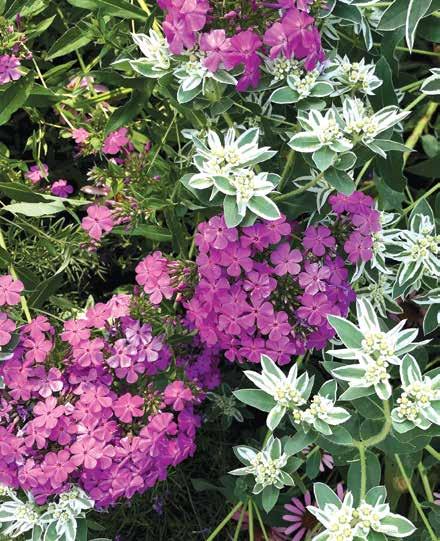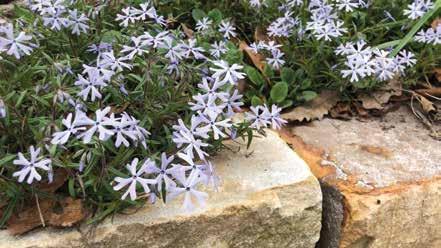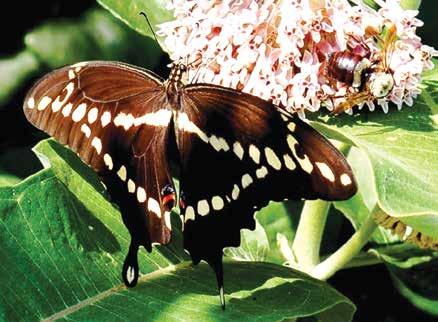
5 minute read
Irresistible Phlox
Photo by Scott Woodbury.

Above: Wild Sweet William; Below: Sand Phlox Left: Garden Phlox with snow on the mountain
Photo by Carol Davit.

Aromas forge strong memories. Take my first encounter with a fragrant native plant—garden phlox. When I was in high school, an older friend showed me her garden. To this day I remember the details. Walking down the sidewalk, approaching masses of pink and white flowers growing along a picket fence, generating distinctive sweet summer smells. The fragrance was so intoxicating that I think of that fortyyear-old memory every summer when phlox is in bloom.
Garden phlox (Phlox paniculata) cultivars are prolific and common in garden centers. But the native straight species is not. Unfortunately, the world of horticulture has overlooked one of nature’s greatest gifts. As a straight species, this phlox is reasonably powdery mildew free, as opposed to the many cultivars that perform so poorly in the humid lower Midwest. (Yogi Berra said it best, “It ain’t the heat, it’s the humility.”)
Garden phlox grows in part shade to full sun, in poorly drained moist soils, or in well-drained dry areas in the garden. Its greatest strength is in its ability to colonize strongly on difficultto-mow shady slopes and compliment other strong-performing species like creek oats (Chasmanthium latifolia), smoothcone sedge (Carex laeviconica), rough goldenrod (Solidago rugosa), false sunflower (Heliopsis helianthoides), woodland knotweed (Persicaria virginiana), curlytop ironweed (Vernonia arkansana), yellow wingstem (Verbesina helianthoides), obedient plant (Phyostegia virginiana), and Joe Pye weed (Eutrochium purpureum). It has the potential to spread from seed and underground rhizomes. Individual seedlings may be clump forming or suckering, so we look for clump formers (we have a large patch with hundreds of seedlings in the upper woods) and transplant them to the more formal section of the garden. Because birds don’t eat many (or any) of the seeds, we deadhead plants growing in the garden when they are finished blooming.
Though each phlox species varies widely in vigor, soil, and sunlight requirements, they have one thing in common. They are all pleasant on the nose. Wild sweet William (Phlox divaricata) is a species with an allure like the sirens from Homer’s ancient Odyssey— so beautiful, yet so dangerous. The scent of the light blue flowers in April is irresistibly sweet. On a scale of aggression (1 being nonaggressive, 10 being most aggressive) wild sweet William scores a 2, compared to the suckering form of garden phlox, which scores an 8 (clump-forming garden phlox is a 5). I’ve never seen too much wild sweet William in a garden, because they prefer well-drained soils in the shade, and many of our garden soils are heavy clay, with less-than-perfect drainage. My favorite companion plants include yellow honeysuckle (Lonicera flava), flowering dogwood (Cornus florida), roundleaved groundsel (Packera aurea), wild columbine (Aquilegia canadensis), sweet Cicely (Osmorhiza claytonia), and celandine poppy (Stylophorum diphyllum).
Sand phlox (Phlox bifida) blooms in March and April, with light blue flowers (or lavender) and gold stamens. It doesn’t need sandy soil to grow well, but it does prefer
SCOTT WOODBURY Horticulturist
Horticulturist Scott Woodbury is the Curator of the Whitmire Wildflower Garden at Shaw Nature Reserve in Gray Summit, MO, where he has worked with native plant propagation, design, and education for 30 years. He also is an advisor to the Missouri Prairie Foundation’s Grow Native! program. Find suppliers of native plants and seeds at www.grownative.org, Resource Guide.
full sun and good drainage. Ours perform nicely in well-drained, average garden soil. Sand phlox makes a great addition to the top of a retaining wall and between boulders and receives an aggressive rating of 1. It also works well in container gardens. Sand phlox blooms in early spring and combines well with rose verbena (Glandularia canadensis) and prairie pussytoes (Antennaria neglecta).
Downy phlox (Phlox pilosa) requires well-drained soils in full sun to part shade. It works well in rock gardens and the edge of a sidewalk or driveway, because it grows wild in rocky areas. It blooms in mid-spring along with fire pink (Silene virginica), western wallflower (Erysimum capitatum), and fringed bluestar (Amsonia cilliata). Downy phlox is a short-lived perennial that comes up in new places from seed, scoring a three on the aggressive scale. It will not be weedy, and the extra seedlings are always welcome in our garden. Its close relative, Ozark phlox (Phlox pilosa var. ozarkana) tolerates a much wider array of soil conditions and is a better choice for most garden soils that have more clay and part shade.
A close relative to garden phlox is meadow phlox (Phlox maculata), which is similar in size and shape, but has purple speckles on the stem and grows in wetlands. It is a good choice for sunny, wet gardens because it is much less aggressive (a three). Another wet-tolerant species is smooth phlox (Phlox glaberrima), which is a shortened version of meadow phlox, but with bright pink flowers and an aggression factor of one or two. Both species are especially useful in rain gardens and wet gardens in full sun or part shade. Stems of smooth phlox may flop over, so plant it next to companions like swamp milkweed (Asclepias incarnata), palm sedge (Carex muskingumensis), and hop sedge (Carex lupulina).
For my whole life, I’ve been enchanted by the unique and irresistible aroma of phlox, and many other aromatic plants. I encourage you to try them as well. Happy gardening!

Often Copied NEVER DUPLICATED ONE QUART COVERS 10,000 SQUARE FEET
Break Up Compacted and Clay Soil Replenish Beneficial Microbes • Replace Micronutrients
Drain Standing Water & Increase Water Utilization
Organic Micronutrients, Enzymes & Acids Professional Strength Conditioner Accept Only Original Earth Right Products for the health & beauty of your lawn & garden.

Feed Your Garden & Containers with SURE BLOOM NATURAL or 6-7-6
ONE QUART COVERS 10,000 SQUARE FEET Use MUSHROOM STUFF to Establish Roots & Avoid Transplant Shock 1 QT covers 20,000 Sq Ft To ship Sure Bloom®, Earth Right Super Stuff® & The Mushroom Stuff® see our website on where to order. To have Earth Right products applied at your location: Tobin Lawn & Landscape (816) 765-5565 or Big Green Turf Management (816) 600-4936.
MADE IN THE HEARTLAND!










